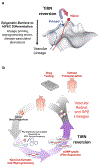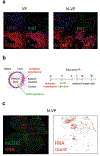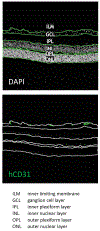Generation of Pericytic-Vascular Progenitors from Tankyrase/PARP-Inhibitor-Regulated Naïve (TIRN) Human Pluripotent Stem Cells
- PMID: 34870835
- PMCID: PMC9529319
- DOI: 10.1007/978-1-0716-1908-7_10
Generation of Pericytic-Vascular Progenitors from Tankyrase/PARP-Inhibitor-Regulated Naïve (TIRN) Human Pluripotent Stem Cells
Abstract
Tankyrase/PARP inhibitor-regulated naïve human pluripotent stem cells (TIRN-hPSC) represent a new class of human stem cells for regenerative medicine that can differentiate into multi-lineage progenitors with improved in vivo functionality. Chemical reversion of conventional, primed hPSC to a TIRN-hPSC state alleviates dysfunctional epigenetic donor cell memory, lineage-primed gene expression, and potentially disease-associated aberrations in their differentiated progeny. Here, we provide methods for the reversion of normal or diseased patient-specific primed hPSC to TIRN-hPSC and describe their subsequent differentiation into embryonic-like pericytic-endothelial "naïve" vascular progenitors (N-VP). N-VP possess improved vascular functionality, high epigenetic plasticity, maintain greater genomic stability, and are more efficient in migrating to and re-vascularizing ischemic tissues than those generated from primed isogenic hPSC. We also describe detailed methods for the ocular transplantation and quantitation of vascular engraftment of N-VP into the ischemia-damaged neural retina of a humanized mouse model of ischemic retinopathy. The application of TIRN-hPSC-derived N-VP will advance vascular cell therapies of ischemic retinopathy, myocardial infarction, and cerebral vascular stroke.
Keywords: Differentiation; Human pluripotent stem cell; Ischemic retinopathy; Naïve pluripotency; PARP; Pericyte; Tankyrase inhibition; Vascular progenitors; Vascular regeneration.
© 2022. The Author(s), under exclusive license to Springer Science+Business Media, LLC, part of Springer Nature.
Figures





Similar articles
-
Vascular progenitors generated from tankyrase inhibitor-regulated naïve diabetic human iPSC potentiate efficient revascularization of ischemic retina.Nat Commun. 2020 Mar 5;11(1):1195. doi: 10.1038/s41467-020-14764-5. Nat Commun. 2020. PMID: 32139672 Free PMC article.
-
Proteogenomic reprogramming to a functional human blastomere-like stem cell state via a PARP-DUX4 regulatory axis.Cell Rep. 2025 May 27;44(5):115671. doi: 10.1016/j.celrep.2025.115671. Epub 2025 May 7. Cell Rep. 2025. PMID: 40338744
-
Chemical Reversion of Conventional Human Pluripotent Stem Cells to a Naïve-like State with Improved Multilineage Differentiation Potency.J Vis Exp. 2018 Jun 10;(136):57921. doi: 10.3791/57921. J Vis Exp. 2018. PMID: 29939183 Free PMC article.
-
Pleiotropic roles of tankyrase/PARP proteins in the establishment and maintenance of human naïve pluripotency.Exp Cell Res. 2020 May 1;390(1):111935. doi: 10.1016/j.yexcr.2020.111935. Epub 2020 Mar 7. Exp Cell Res. 2020. PMID: 32151493 Free PMC article. Review.
-
Generation of Human Pluripotent Stem Cell-derived Endothelial Cells and Their Therapeutic Utility.Curr Cardiol Rep. 2018 May 5;20(6):45. doi: 10.1007/s11886-018-0985-8. Curr Cardiol Rep. 2018. PMID: 29730842 Free PMC article. Review.
Cited by
-
Immunotherapeutic Targeting of NG2/CSPG4 in Solid Organ Cancers.Vaccines (Basel). 2022 Jun 26;10(7):1023. doi: 10.3390/vaccines10071023. Vaccines (Basel). 2022. PMID: 35891187 Free PMC article. Review.
References
Publication types
MeSH terms
Substances
Grants and funding
LinkOut - more resources
Full Text Sources

